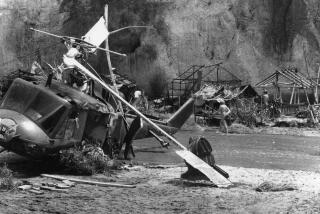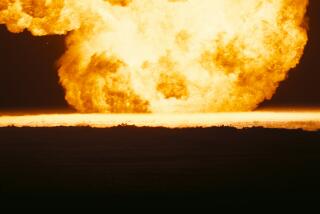Long-Delayed Trial in Three ‘Twilight Zone’ Deaths Opens
- Share via
Director John Landis and four associates ignored common sense and warnings of danger in filming a Vietnam battle scene that left three actors dead during the making of “Twilight Zone: The Movie,” Deputy Dist. Atty. Lea Purwin D’Agostino asserted Wednesday.
“These were not deaths in which someone can get up and wipe the bloody looking ketchup off their faces. . . . They were very, very real deaths,” the prosecutor said as the manslaughter trial finally got under way.
But Landis’ attorney countered that the gruesome 1982 film set tragedy resulted from “unforeseeable . . . and even bizarre events,” set in motion by the failure of a special-effects employee to properly detonate an explosion.
If the helicopter struck by the resulting fireball spun out of control in a slightly different manner, defense counsel James F. Neal told jurors, “it would have been the defendants here that would have been dead.”
The opposing attorneys voiced their widely conflicting views in impassioned opening statements to the jury in the long-delayed trial.
In a case expected to continue for four months, Landis, associate producer George Folsey Jr., unit production manager Dan Allingham, helicopter pilot Dorcey A. Wingo and special-effects coordinator Paul Stewart are accused of involuntary manslaughter in the deaths of actor Vic Morrow, 53, and Renee Chen, 6, and Myca Dinh Lee, 7.
The trio were killed when the crippled helicopter crashed down upon them as Morrow, carrying the two children, waded across a river in what was to be the final scene of the film. The jury will be shown the footage, which did not appear in the movie.
Landis, Allingham and Folsey have admitted that they illegally hired the children without a state permit--but they were not charged with that offense. Rather, the three are charged with manslaughter for having allegedly endangered the children’s lives. Stewart, Wingo and Landis are also charged with manslaughter stemming from alleged criminal negligence.
Using charts and an elaborate scale model of the movie set near Saugus, D’Agostino and Neal told the jury and an overflow crowd of spectators during hour-plus presentations what they believe the evidence in the case will ultimately prove.
The fatal scene, D’Agostino contended, “could have been done without sacrificing any artistic reality, so to speak, without sacrificing any human life whatsoever.”
For example, second assistant director Anderson House, she said, will testify that he suggested using midgets or dolls rather than the children. However, House was told by Allingham that Landis “did not think dolls or dummies would give him the real-life effect,” D’Agostino said.
Landis--apparently the first Hollywood director criminally charged for his role in shooting a movie--did not adequately plan the fatal scene with his associates, D’Agostino added.
Neal, on the other hand, contended that prosecution witnesses will be engaging in “Monday morning quarterbacking” and that, specifically, House was not concerned about endangering the children. Rather, Neal said, House was worried about the fact that the children were illegally employed.
Neal, terming the tragedy “unforeseen and unforeseeable,” said that Landis, 36, used the actors in the fatal scene only because he and his fellow film makers believed it would be safe.
What they did not count on, Neal said, was special-effects man James Camomile setting off the mortar explosions that hit the helicopter before the aircraft “was a safe distance (away).” Camomile, who was granted immunity by the prosecution, is scheduled to testify for the prosecution.
Neal charged that Camomile “violated the first principle of his profession” by not making sure the area was clear before setting off the special effect.
In addition, Neal said, one of those explosions misfired, sending a fireball into the sky that engulfed the tail of the helicopter, causing its tail rotor to peel off due to the heat. No such incident has been recorded previously in aviation history, Neal contended.
The downed helicopter, Neal said, came to rest within five or six feet from where Landis was directing the scene.
More to Read
Only good movies
Get the Indie Focus newsletter, Mark Olsen's weekly guide to the world of cinema.
You may occasionally receive promotional content from the Los Angeles Times.










